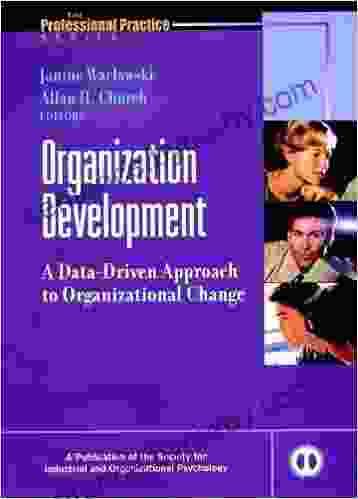Data-Driven Approach to Organizational Change: The Key to Successful Transformations

4.1 out of 5
| Language | : | English |
| File size | : | 4114 KB |
| Text-to-Speech | : | Enabled |
| Screen Reader | : | Supported |
| Word Wise | : | Enabled |
| Print length | : | 400 pages |
| Lending | : | Enabled |
In today's rapidly evolving business landscape, organizations must embrace change as a constant companion. However, navigating the complexities of change can be daunting without a clear roadmap. Enter the concept of a data-driven approach to organizational change – a transformative framework that empowers organizations to make informed decisions, mitigate risks, and achieve lasting success.
This comprehensive article delves into the intricacies of data-driven organizational change, exploring its benefits, methodologies, best practices, and real-world examples. By harnessing the power of data, organizations can gain unprecedented insights into their operations, stakeholders, and market dynamics, enabling them to tailor change initiatives to their specific needs and aspirations.
Benefits of a Data-Driven Approach
- Informed Decision-Making: Data provides a solid foundation for making evidence-based decisions, reducing the risk of costly mistakes and ensuring that change initiatives are aligned with organizational objectives.
- Enhanced Risk Mitigation: By analyzing historical data and identifying potential roadblocks, organizations can proactively address risks and develop contingency plans, minimizing disruptions and maximizing the chances of successful change.
- Tailored Change Strategies: Data empowers organizations to segment their stakeholders, understand their unique needs, and customize change strategies accordingly, fostering a sense of ownership and increasing the likelihood of adoption.
- Continuous Improvement: Data enables organizations to track progress, measure outcomes, and make data-driven adjustments throughout the change process, ensuring continuous improvement and sustained success.
Methodologies and Best Practices
- Establish Clear Data Objectives: Define the specific data points and metrics that will measure the success of your change initiatives.
- Collect and Analyze Data: Gather data from multiple sources, including surveys, interviews, performance metrics, and market research.
- Identify Patterns and Trends: Analyze the data to identify patterns, trends, and insights that can inform your change strategy.
- Build Data-Driven Models: Create predictive models based on historical data to forecast potential outcomes and guide decision-making.
- Communicate Data Effectively: Share data insights with stakeholders in a clear and compelling way, fostering understanding and buy-in.
Real-World Examples
Numerous organizations have successfully implemented data-driven approaches to organizational change. Here are a few notable examples:
- Google: Google used data analytics to identify and address employee concerns, resulting in increased employee satisfaction and improved performance.
- Our Book Library: Our Book Library's data-driven approach to customer service has enabled them to personalize experiences, enhance customer loyalty, and drive business growth.
- Netflix: Netflix's data-driven decision-making has revolutionized the entertainment industry, allowing them to tailor content recommendations and create highly successful original programming.
Embracing a data-driven approach to organizational change is a transformative step towards achieving sustainable success in an ever-changing business environment. By leveraging data to inform decision-making, mitigate risks, and tailor change initiatives, organizations can unlock their full potential and emerge stronger and more adaptable in the face of ongoing challenges.
4.1 out of 5
| Language | : | English |
| File size | : | 4114 KB |
| Text-to-Speech | : | Enabled |
| Screen Reader | : | Supported |
| Word Wise | : | Enabled |
| Print length | : | 400 pages |
| Lending | : | Enabled |
Do you want to contribute by writing guest posts on this blog?
Please contact us and send us a resume of previous articles that you have written.
 Book
Book Novel
Novel Page
Page Chapter
Chapter Text
Text Story
Story Genre
Genre Reader
Reader Library
Library Paperback
Paperback E-book
E-book Magazine
Magazine Newspaper
Newspaper Paragraph
Paragraph Sentence
Sentence Bookmark
Bookmark Shelf
Shelf Glossary
Glossary Bibliography
Bibliography Foreword
Foreword Preface
Preface Synopsis
Synopsis Annotation
Annotation Footnote
Footnote Manuscript
Manuscript Scroll
Scroll Codex
Codex Tome
Tome Bestseller
Bestseller Classics
Classics Library card
Library card Narrative
Narrative Biography
Biography Autobiography
Autobiography Memoir
Memoir Reference
Reference Encyclopedia
Encyclopedia Jason E Hamilton
Jason E Hamilton Jean Clottes
Jean Clottes Robin Meloy Goldsby
Robin Meloy Goldsby James Ferguson
James Ferguson Jean Dominique Bauby
Jean Dominique Bauby Tegan Maher
Tegan Maher Sara Wheeler
Sara Wheeler James Russell
James Russell Mel Rolfe
Mel Rolfe James Patterson
James Patterson Kel Carpenter
Kel Carpenter Janis Frank
Janis Frank Jaya Baleswari Ramachandra
Jaya Baleswari Ramachandra Jay Cassell
Jay Cassell Stephen Krensky
Stephen Krensky James O Prochaska
James O Prochaska Stuart Stirling
Stuart Stirling Steve Herman
Steve Herman William H Mcraven
William H Mcraven Osamu Tezuka
Osamu Tezuka
Light bulbAdvertise smarter! Our strategic ad space ensures maximum exposure. Reserve your spot today!

 Eugene PowellUnlock the Secrets to Thriving in Commercial Real Estate: A Comprehensive...
Eugene PowellUnlock the Secrets to Thriving in Commercial Real Estate: A Comprehensive...
 Cormac McCarthyUnveiling the Luminous Memoir: A Journey Through Racism, the Care System, and...
Cormac McCarthyUnveiling the Luminous Memoir: A Journey Through Racism, the Care System, and... Charles DickensFollow ·16.2k
Charles DickensFollow ·16.2k Jaylen MitchellFollow ·2k
Jaylen MitchellFollow ·2k Kirk HayesFollow ·12.5k
Kirk HayesFollow ·12.5k Brent FosterFollow ·10.7k
Brent FosterFollow ·10.7k Ivan CoxFollow ·11.4k
Ivan CoxFollow ·11.4k Jerry HayesFollow ·2k
Jerry HayesFollow ·2k Colt SimmonsFollow ·16.4k
Colt SimmonsFollow ·16.4k Lawrence BellFollow ·10.1k
Lawrence BellFollow ·10.1k

 Franklin Bell
Franklin BellHow Businesses Can Thrive In The New Global Neighborhoods
The world is becoming...

 Rob Foster
Rob FosterCard Manipulations Volume 1: A Masterclass in Deception...
Unveiling the...

 Enrique Blair
Enrique BlairUnveil the Secrets of Card Manipulation: Dive into "More...
Step into the captivating world...

 Jamal Blair
Jamal BlairComedy Fillers 200 Quips One Liners Jean Hugard
Unlock the Secrets of...

 Chase Simmons
Chase SimmonsUnlock Financial Independence: A Comprehensive Guide to...
In a world where financial security seems...

 Dion Reed
Dion ReedUnveiling Global Market Entry Strategies: A Comprehensive...
Global Market Entry Strategies:...
4.1 out of 5
| Language | : | English |
| File size | : | 4114 KB |
| Text-to-Speech | : | Enabled |
| Screen Reader | : | Supported |
| Word Wise | : | Enabled |
| Print length | : | 400 pages |
| Lending | : | Enabled |








